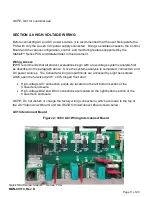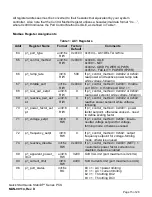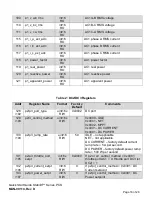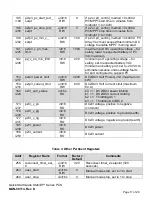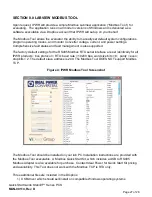
Page 24 of 28
Quick Start Guide Stabiliti™ Series PCS
MAN-00114, Rev D
5. Run for desired time and shut down the AC1 microgrid output by updating register
‘user_stop’ to 1.
AC Microgrid
– Using Dual Batteries
AC1 = FPWR / DC2 = PWR / DC3 = NET
This energy flow example uses two batteries. D
epending upon DC2’s PWR sign and
setpoint, and microgrid load, one or both of the batteries will support the microgrid.
“Summing” of the batteries to the AC1 voltage-forming output occurs when DC2’s negative
power setpoint is below the microgrid load. Because DC3 is set to NET, it will make up the
shortfall to ensure the microgrid load is supported.
“Splitting” of DC2 occurs when DC2’s negative power setpoint is above the microgrid load.
In this flow case, DC2 services the microgrid entirely and excess power available from DC2
is netted to DC3 (DC2 battery charging the DC3 battery).
NOTE: Dual battery systems could use smaller capacity lithium-
ion ‘”power” batteries on DC3 to
support rapidly changing microgrid load demands and larger capacity lead-
acid ”energy”
batteries on DC2 to support average microgrid demand.
Solar + Storage Microgrid
AC1 = FPWR / DC2 = MPPT / DC3 = NET:
This energy flow example uses a PV Array or PV simulator on DC2 with a 500 Vdc+ battery
on DC3. Note that these DC port assignments are easily swapped.
“Summing” of PV and battery to support the AC1 microgrid load occurs when the available
solar resource cannot support the microgrid alone (due to low or highly-variable irradiance).
“Splitting” occurs when the available solar resource exceeds the microgrid’s load. The PV
Array connected to DC2 completely supports the microgrid and any excess power available
from DC2 is diverted to DC3 (charging the DC3 battery).
NOTE: During periods of high-irradiance and modest microgrid load, your system controller
must proactively manage the DC3 battery State of Charge (SoC). This is accomplished by
setting a lower soft-power limit on the DC2 port, curtailing PV power, and preventing battery
overcharging. Adjust the soft power limit higher once batteries are below max SoC.
Solar + Storage Microgrid, with Genset Backup
AC1 = FPWR / DC2 = PWR / DC3 = NET
At night, or during periods of low-irradiance and high microgrid load, the Solar microgrid use
case detailed above may be dynamically re-configured to allow an external AC genset
equipped with a rectifier (rectifier connected to DC2 and shared with the PV Array) to support
the microgrid while also charging the battery on DC3.
In this use case, the external system controller will set an import power level on DC2 that is
higher than the microgrid load. The generator seamlessly supports the microgrid and excess


